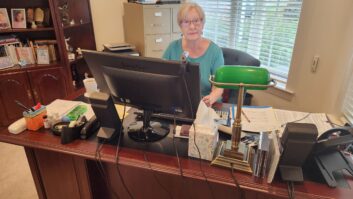The Society of Broadcast Engineers commended the FCC for its inquiry into spectrum usage but says the undertaking will be daunting.
In fact, the SBE goes so far as to recommend the commission consult with third-party contractors and other experts to help find ways to maximize the invisible infrastructure; noting the “highly complex and technical nature” of the FCC’s spectrum study.
The FCC set out this summer to study the use of spectrum and gain a better understanding of data that would allow for more efficient spectrum use. The Wireless Telecommunications Bureau in a notice of inquiry seeks to review how spectrum is measured and how new technologies, like spectrum sharing techniques, might mean less congestion in bands.
“[The FCC] will explore the feasibility, benefits and limitations of techniques to understand non-federal spectrum usage,” according to the NOI. The FCC says the hope is to make way for new wireless technologies and services in the United States.
In the U.S., regulatory responsibility for the radio spectrum is divided between the FCC and the National Telecommunications and Information Administration. The FCC administers spectrum for non-federal or commercial use, while NTIA is responsible for spectrum used by the U.S. government.
The highly technical “Advancing Understanding of Non-Federal Spectrum Usage” inquiry asks how the FCC can “better obtain more sophisticated knowledge of non-federal spectrum usage — and how we could take advantage of modern capabilities for doing so in a cost-effective, accurate, scalable and actionable manner.”
The FCC says in its inquiry that “our existing repositories provide limited, if any, real-time data on the extent of actual spectrum utilization.”
The SBE says the commission should focus on the “first steps” of the technical process, like gaining a better understanding of current spectrum utilization.
As demand on the airwaves grows, SBE says it’s critical that the FCC understand utilization in geography, frequency and time. “The FCC must approach this overarching process deliberately and thoughtfully, by establishing a clear series of steps from initial conceptualization to final implementation,” Ted Hand, the SBE president, wrote in the filing.
The SBE says after a clear definition of “spectrum use” is established, the commission should further prepare by studying the many and varying ways the defined spectrum use occurs, which, in turn, will permit the FCC to analyze and determine which measurement techniques will capture such uses accurately The FCC must also settle on a definition of what is to be measured.
The engineering organization told the FCC: “Actual data collection should only begin once the foregoing groundwork has been laid, and the FCC should consider outsourcing such data collection and any corresponding technical studies to appropriate third-party experts rather than proceed on its own accord.”
The group cautions that the definition of spectrum usage must be broad enough to encompass all types of non-federal use that the commission is interested in studying. “SBE therefore respectfully submits that, to obtain a true and accurate picture of the current RF environment, the definition of spectrum use should account for both continuous and intermittent use — including year-round, seasonal and temporary use — as well as fixed and mobile use, unlicensed use and unauthorized use, just to name some of the most common types of spectrum occupancy.”
As an example, the SBE notes that the broadcast industry utilizes spectrum in myriad ways. “Some usage is fixed and continuous, like many television and radio broadcast streams. Other operations are intermittent and/or mobile, like mobile electronic news gathering. In the case of AM radio, as the NOI notes, measured usage may vary significantly based on the time of day and contour being assessed,” the SBE wrote.
In addition, that definition must incorporate a number of technical details and subcategories.
Studying spectrum is a difficult thing, it continued, since no single approach is feasible to measure spectrum occupancy. It said that different frequency bands and services have unique characteristics, and the methods used to assess occupancy must vary accordingly. “This is a complex and challenging task, but it is essential if the commission is to effectively manage the non-federal spectrum bands.”
The SBE also said it believes “skilled and hyper-specialized industry experts” should be brought to bear on the difficult task.
The engineers conclude: “In order to successfully meet the challenge, the commission should carefully define spectrum use to encompass the wide range of usage it wishes to assess, and should employ qualified and specialized third parties to thoroughly study the wide range of spectrum use prior to beginning data collection efforts.”
FCC Chairwoman Jessica Rosenworcel has said that the study of spectrum usage is a critical endeavor for the agency charged with overseeing the nation’s spectrum infrastructure. “Right now, so many of our commercial spectrum bands are growing crowded. Hundreds of millions of wireless connections — from smartphones to medical sensors — are using this invisible infrastructure. And that number is growing fast,” Rosenworcel said in comments when the commission released its inquiry.
Rosenworcel in an online post raised the idea of using artificial intelligence to help maximize usage of non-federal spectrum: “Now enter AI. A large wireless provider’s network can generate several million performance measurements every minute. Using those measurements, machine learning can provide insights that help better understand network usage, support greater spectrum efficiency and improve resiliency by making it possible to heal networks on their own.”
You can read the full text of SBE’s comments (WT Docket 23-232) on the FCC’s website.











